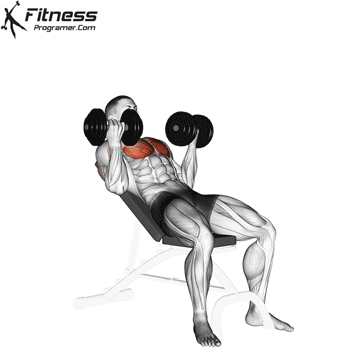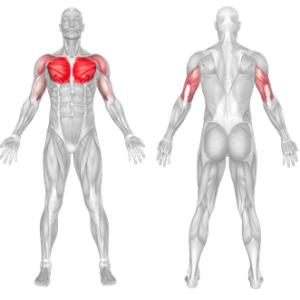Reverse Grip Incline Dumbbell Press Overview
The reverse grip incline dumbbell press is an upper-body exercise targeting the upper pectoral muscles. By using a reverse grip (palms facing you), the angle of muscle engagement changes, offering unique benefits for chest development.
How to do:

Setup
- Adjust the bench to an incline angle of 30–45 degrees.
- Grab a pair of dumbbells and sit on the bench with feet flat on the ground.
- Hold the dumbbells with a reverse grip (palms facing you), and position them at shoulder level with elbows bent.
Execution
- Exhale as you press the dumbbells upward in a controlled motion, keeping your palms facing inward throughout.
- Fully extend your arms at the top without locking your elbows.
- Inhale as you slowly lower the dumbbells back to the starting position, maintaining control.
Common Mistakes
- Using Too Much Weight: Overloading can compromise form and increase injury risk. Start with lighter dumbbells to master the movement.
- Improper Grip: Failing to maintain a true reverse grip can shift focus away from the targeted muscles.
- Flared Elbows: Keep elbows at a moderate angle (around 45 degrees) to avoid shoulder strain.
- Rushed Reps: Perform the exercise slowly to maximize control and muscle engagement.
Benefits of Reverse Grip Incline Dumbbell Press
1. Enhanced Upper Chest Activation
- The reverse grip adjusts the angle of the arms and shoulders, shifting more emphasis to the clavicular head of the pectoralis major (upper chest).
- This increased focus on the upper chest is ideal for creating a fuller, more defined chest, especially for individuals aiming to develop a balanced and aesthetic upper body.
- It’s an excellent complement to traditional pressing movements that may predominantly target the middle and lower portions of the chest.
2. Variation in Training
- Incorporating the reverse grip provides a fresh angle for targeting the chest and upper body muscles, helping to prevent training plateaus.
- By varying grip styles, you reduce the risk of overuse injuries from repetitive movement patterns.
- This variation keeps your workouts challenging and engaging, encouraging continuous progress in both strength and muscle development.
3. Reduced Shoulder Stress
- The reverse grip can feel more natural for individuals with shoulder discomfort or previous injuries, as it encourages a more neutral arm position.
- It reduces strain on the anterior deltoids and allows for smoother motion, making it a safer alternative for those with joint sensitivity.
- This joint-friendly benefit ensures that the exercise can be performed effectively without compromising comfort or safety.
Muscles Worked

